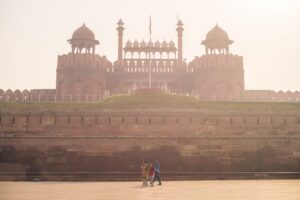![<em><strong>Crop burning in the fields of southeast Punjab. Is the practice responsible for Delhi's pollution crisis? Image credit: Neil Palmer (CIAT) [CC BY-SA 2.0 (https://creativecommons.org/licenses/by-sa/2.0)], via Wikimedia Commons</strong></em>](/wp-content/uploads/2019/03/NP_India_burning_64_6314804017.jpg)
Every year, paddy field farmers burn between seven and eight million tonnes of crop waste, principally in Haryana and Punjab. Crop burning has been on the rise since the beginning of the decade, at a cost of US$30 billion and 60,000 pollution-related deaths. Delhi feels the burden acutely: particulate matter emissions due to crop burning are seventeen times that of any other pollution source.
Pollution in the national capital region has caused a sharp decline in air quality. “The pollution has increased in the past three days,” one resident told the media. “I am feeling very suffocated. There is so much haze everywhere. I will soon start wearing an anti-pollution mask during morning walks. The government must do something to combat the air pollution in the capital.”
“Delhi has become a gas chamber due to pollution from stubble burning in the neighbouring states,” Kejriwal said, disputing claims that the stubble burning accounted for a relatively minor fraction of pollution in the city. Earlier in the week, the Environment Pollution (Prevention and Control) Authority (EPCA) attributed at least ninety percent of pollution in the city to local sources.
“The stubble burning activity in north Indian states of Haryana, Punjab and nearby border regions is moderate, but has shown an increasing trend over the last 72 hours,” reported the System of Air Quality and Weather Forecasting And Research (SAFAR). “Additionally, a few new fires are observed over western Uttar Pradesh.”

“There is pollution from inside and there is pollution from outside,” Kejriwal countered. “Only blaming people of Delhi for pollution is wrong. We should congratulate people of Delhi for accepting several harsh measures to curb pollution. There is no city in the country that has accepted such harsh measures. They were able to reduce pollution by 25 percent.” (The 25 percent claim has been critiqued for its accuracy).
A data deficit is to blame for the difficulties in assessing accurately the scope of the pollution crisis and its causes in the national capital, Kejriwal suggested. “Various reports have come from different perspectives; some of them are based on old data,” he said. “No agency has real-time data. If we decide causes of pollution in October 2019, based on the data in 2017 or 2018, it won’t be correct.”
Earlier in the week, the Delhi government urged the Centre to share the technical expertise of SAFAR. “SAFAR also has the technology and equipment to do some allocation of pollution on real time basis,” state environment minister Kailash Gehlot said. Meanwhile, Kejriwal has announced the establishment of a real-time monitoring system to come into effect from next year.
“We have tied up with Washington University for this and a centre has been set up near India Gate,” Kejriwal explained. “From April, 2020, we’ll be able to provide the details of air pollution and its sources in an interval of every four hours. The machine has already been installed. But, for specific outcome, one year base-level study is required. So since March, we have been collecting samples on a daily basis to prepare the base data of a year of Delhi’s air pollution.”
Of local sources, Kejriwal says that the national capital is ready. “A comprehensive winter action plan has been prepared by the Delhi government,” he said. “The odd-even scheme is aimed at limiting the emission by vehicles in the air over that period…to fight pollution, our government has banned [the] use of DG [diesel generator] sets, started hotspot monitoring, announced dust control measures and formed teams for keeping vigil on the construction activities and to stop garbage burning.”
However, Kejriwal maintains that, unless crop burning is addressed, the situation will deteriorate further. “We need to do much more,” he acknowledges, “but unless there are efforts to tackle the smoke due to crop burning in neighbouring states, Delhi’s problems will continue.”

